2. 中国地质大学地球科学与资源学院, 北京 100083
2. School of Earth Sciences and Resources, China University of Geosciences, Beijing 100083, China
锗(Ge)元素因其具有良好的半导体性能,而成为现代信息产业最重要的金属之一(胡瑞忠等,2000;European Commission, 2014①),广泛应用于聚合物催化剂、红外光学、光纤系统、电子光学、太阳能电力等领域(Höll et al., 2007)。尤其是近年来随着光纤需求的回暖以及红外光学在军用、民用领域应用的不断扩大,全球对锗的需求量不断增加,预计仅中国在2018年锗的消费量就将达到131t。与此同时,作为一种重要的战略物资,世界各国都在逐步将锗作为一种国防储备资源(前瞻产业研究院,2018②),因此加强锗矿的找矿工作势在必行。锗作为一种分散元素,因其含量低且极为分散(涂光炽等,2004),一般很难形成独立矿床,目前主要作为一些铜、铅、锌、金、银等富含硫化物的矿床和一些煤矿的副产品而被利用(胡瑞忠等,2000)。铅锌硫化物矿床作为工业锗两大主要来源之一,也是锗矿勘查的主要目标(胡瑞忠等,1997)。作为我国西南地区大面积低温成矿域的一部分(胡耀国等,2000;涂光炽等,2004;Hu and Zhou, 2012; Hu et al., 2017a, b),川滇黔地区是寻找与铅锌硫化物矿床相伴生的锗资源的重要目标区,目前该区已经发现多个富锗铅锌矿床,如四川大梁子、天宝山,云南会泽、富乐厂、茂租、毛坪,贵州杉树林、青山等(薛步高,2004;张羽旭等,2012),并且还有大量的铅锌硫化物矿床没有进行锗的综合利用评价,因此找矿潜力巨大,在该区开展锗的找矿工作,有望取得新的更大的突破。
① European Commission. 2014. The European Critical Raw Materials Review. European Commission Memo. Brussels: European Commission, 1-7
② 前瞻产业研究院. 2018. 2018~2023年中国锗行业产销需求与投资预测分析报告. 1-100
在我国目前还没有成熟的专门寻找锗矿的方法,锗矿的发现大部分是在勘查煤矿、铅锌矿以及铁矿过程当中综合评价时确定的,如:在评价云南临沧煤矿的过程中发现锗主要富集在成熟度较低的煤层中(王婷灏等,2016);在评价广西环北铅锌硫铁矿床时发现锗与铅锌矿同步富集(《中国矿床发现史·广西卷》编委会,1996);1960年在评价湖北万寿山风化淋滤型铁矿床时发现了锗资源,其中赤铁矿中锗的含量达到了工业品位(《中国矿床发现史·湖北卷》编委会,1996);云南会泽铅锌锗矿床,是解放后在前苏联专家的帮助下,通过对铅锌矿床伴生元素的定性、定量分析以及随后在含锗铅锌烟尘中提取锗实验的成功,使得会泽铅锌矿中的锗资源得以发现和应用(会泽铅锌矿,1992③)。因此,迫切需要对专门寻找锗的找矿方法进行深入研究,提升锗的找矿能力,以期发现更大的锗矿床。化探作为有效的找矿手段之一,在找矿过程当中发挥了巨大作用,据不完全统计,运用地球化学方法发现的矿床约占发现矿床总数的71%(Xie and Cheng, 2014; Wang et al., 2016),因此,在锗矿找矿过程中,化探应当发挥其作用。虽然大量研究发现,在铅锌硫化物矿床中,锗主要赋存在闪锌矿中,尤其是铁含量较低的浅色闪锌矿中(胡瑞忠等,2000;Höll et al., 2007;Alexandre et al., 2018;Cugerone et al., 2018),但是鉴于锗在表生状态下物理、化学性质的研究还相对薄弱,与锌的共生分离关系并不十分明确(刘英俊等,1984),这使得在利用水系沉积物或者土壤测量数据进行区域找矿预测时,是采用以锗找锗的直接找矿方法,还是采用以锌等寄主元素找锗的间接找矿方法,成为一个迫切需要解决的问题,本文主要针对这一问题进行研究。
③ 会泽铅锌矿. 1992.云南会泽铅锌矿志.昆明:会泽铅锌矿, 1-485
可能是由于经费有限、分析技术不成熟或者重视程度不够等原因,在全国1:20万化探扫面过程中,只对常规的包括锌、铅、银等在内的39种元素进行分析,并没有对锗等分散元素进行分析测试(程志中等,2014),锗元素直接找矿的效果难于评价。庆幸的是,2000年~2010年期间,在中国地质调查局的领导下,中国地质科学院地球物理地球化学勘查研究所先后组织开展了包括锗等分散元素在内的76个元素的地球化学填图计划,范围涉及南方12省,涵盖整个川滇黔地区(程志中等,2014)。虽然是低密度地球化学填图,但由于分析对象是1:20万水系沉积物副样的组合样,因此其在圈定矿田级找矿远景区以及对指导进一步化探找矿工作具有重要意义。本文将川滇黔地区作为研究范围,以锌、锗元素作为研究对象,综合分析其数字特征和分布规律,确定找矿指示元素;通过比较C-A等多种异常下限确定方法,识别找矿元素地球化学块体;并结合多种地质因素筛选出矿田级找矿远景区,为进一步的找矿工作部署提供依据。
1 川滇黔地区地质矿产特征 1.1 地质特征川滇黔研究区(25°00′~29°30′N、102°00′~105°30′E)(图 1)在大地构造位置上位于扬子板块西南缘,安宁河断裂带以东的台缘凹陷带内(刘文周和徐新煌,1996)。区内大的区域性断裂构造大致可分为三组,其中NS向断裂带是区内最重要的断裂带,如安宁河深大断裂、石棉-小江断裂等,严格控制着大地构造单元的发育和发展,也是在区域上控制铅锌(锗)矿床分布的主要构造;NE向断裂和NW向断裂控制区内次一级构造单元的发育,其构造交汇部位也是矿床产出的有利部位,其中NW向断裂带以垭都-紫云深大断裂最具代表性。
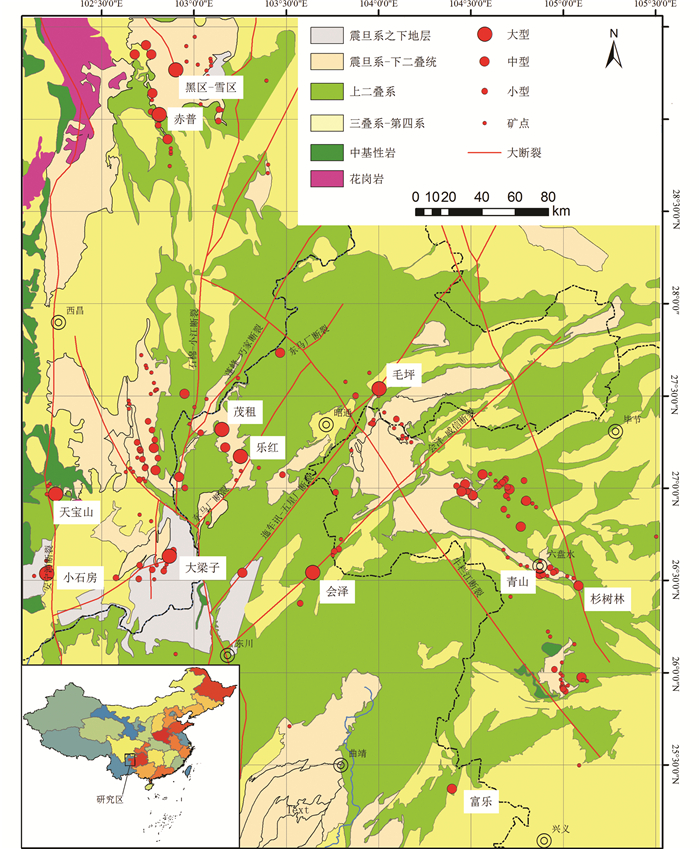
|
图 1 川滇黔铅锌(锗)成矿区地质矿产图 Fig. 1 The geological and mineral resources sketch map of the Chuan-Dian-Qian Pb-Zn(Ge) metallogenic region |
区内地层分布非常复杂,大致可分为前震旦纪地层、震旦系-下二叠统、上二叠统和二叠纪之后的地层。其中,前震旦纪地层(如:昆阳群和会理群),其岩性主要为一套浅变质岩,主要分布在研究区的西南部,其次在西北部和东南部有少量分布;震旦系-下二叠统(如:震旦系上统灯影组,寒武系下统筇竹寺组,泥盆系中统海口组、上统宰格组,石炭系下统大塘组、摆佐组,石炭系中统威宁组,石炭系上统马坪组,二叠系下统梁山组、栖霞组以及茅口组),是铅锌(锗)矿床的主要容矿围岩,其岩性以白云岩为主,次为灰岩、砂岩、泥岩以及页岩等,在区内广泛分布,但主要集中在研究区的西部;二叠系上统峨眉山玄武岩组,岩性为黑褐色、灰紫色气孔状、杏仁状及致密块状玄武岩,在成因上可能与铅锌(锗)矿有一定的联系,但也存在较大争议(柳贺昌,1995;黄智龙等,2001;李文博等,2002;顾尚义,2006;陈大和刘义,2012;李波等,2012)。二叠纪之后形成的地层(主要包括三叠系、侏罗系-第四系),其岩性主要为碎屑岩,大部分分布在研究区四周。
区内侵入岩体主要包括花岗岩体和基性-超基性岩体,规模有限,花岗岩体主要分布在研究区的西北角,基性-超基性岩体主要分布在研究区的西部,目前看来与锗的成矿关系不大。
1.2 铅锌锗矿产特征区内铅锌(锗)矿床广泛分布,仅研究区内就有矿床(点)209个(图 1),其中锗资源储量达到规模以上的铅锌锗矿床8个,包括会泽、天宝山、富乐厂、大梁子、毛坪、茂租、杉树林和青山,其含矿围岩、控矿构造、矿体特征、矿石矿物、脉石矿物、矿床储量、矿石品位以及围岩蚀变等基本地质特征如表 1所示。
|
|
表 1 川滇黔地区重要富绪铅锌5厂床地质特征表 Table 1 Geological feature of the important Pb-Zn-Ge deposits in Chuan-Dian-Qian area |
① 何兴武,曹贤义,靳振国,李佐光,刘廷祥,潘天新.1991.四川省会东大梁子铅锌矿床1994 ~2094中段生产勘探储量报告.昆明:冶金工业部西南地质勘查局昆明地质调查所,1-171
② 宋铁和,李恭柏,张帝辉,申伯书,刘石坤.1982.四川省会理县天宝山铅锌矿Ⅱ号矿体详查勘探地质报告.成都:四川冶金地质勘探公司六0二队,1-100
③ 《贵州省水城县杉树林铅锌矿床补充勘探储量报告》编委会.1965.贵州省水城县杉树林铅锌矿床补充勘探储量报告.贵州有色地质勘探公司第二地质勘探队,1-51
2 分析预测方法 2.1 地球化学数据集中国于20世纪70年代末开展了1:20万区域化探全国扫面计划,按照每1km2采集1~2个水系沉积物样品的原则,在二级水系或上一级水系口上,采集有利于多元素聚集的淤泥、粉砂或细砂,采样点控制的汇水盆地面积一般不小于1/3km2,不大于3km2,采集粒度为小于60目的细粒物质。截止到2006年,已经覆盖了全国700万平方千米的范围,按计划要求,一部分样品用于分析测试,一部分作为地质实物资料(副样)存放于各省样品库中(Xie and Cheng, 2014)。
川滇黔研究区所收集到的463个水系沉积物组合样品的76个元素的分析数据,是将川滇黔研究区(四川、云南、贵州交界区)内已经完成的1:20万区域化探扫面保存的副样在每个1:5万图幅内将所有原始样品(副样)组合成1件分析样品,按每km2抽取5g样品参与组合,若有两件或两件以上样品时,只抽取两件样品,按等重量原则组成总共重5g组合样品参与组合,抽样原则是抽取控制面积大的水系沉积物,对于副样为4km2一个组合样保存的样品,每件样品抽取20g参与组合。参与样品组合的单位有四川省地质矿产勘查开发局物探队、化探队,云南省地质调查院,贵州省地质调查院,参与样品分析方法研究和样品测试工作的单位为中国地质科学院地球物理地球化学勘查研究所。此次作为研究对象的Zn和Ge元素,其分析测试方法分别是X射线荧光光谱法(XRF)和氢化物发生原子荧光光谱法(HG-AFS),检出限分别为1.8×10-6和0.02×10-6,均分别低于地壳丰度值76×10-6和1.6×10-6(程志中等,2014)。
2.2 探索性数据分析方法探索性数据分析方法作为一种新型的统计分析手段,近年来在包括地质矿产在内的许多行业得到了广泛的应用,并取得了明显成效(张璇,2013; Asadi et al., 2014; Zhou et al., 2015)。其强调了数据本身的价值,而不要求其必须符合正态分布,可以更加客观地发现数据的规律,找到数据的稳健耐抗模式,从而发掘出数据的隐藏信息。在探索性数据分析中,统计参数和统计图形是数据分析的主要手段,其中,统计图形在探索性统计分析中扮演着非常重要的角色(谢佳斌和金勇进,2009),常见的统计图形有直方图、累计分布图、Q-Q图、箱式图、散点图等。本文将采用探索性数据分析方法并结合地球化学图探究Zn、Ge元素数据的分布特征和规律。
2.3 地球化学块体与C-A方法地球化学块体的概念是由Doe(1991)提出的,是指富含某种或某些元素的大岩块,它们是从地球形成到演化至今不均匀性的总显示,能够为矿床的形成提供物质来源。谢学锦等(谢学锦, 1995; 谢学锦和向运川, 1999)提出利用地球化学扫面数据圈定地球化学块体,并将地球化学块体定义为面积大于1000km2的地球化学异常。地球化学块体与矿集区往往存在着密切的关系,有大型矿集区的存在,一定有地球化学块体的存在(王学求等,2007)。作为形成大型矿集区的必要条件,圈定地球化学块体显得尤为重要。要圈定地球化学块体,确定代表地球化学块体边界的地球化学异常下限是关键(李随民等,2009),其实质就是将不同总体(如:地球化学块体和非地球化学块体)加以区分,将地球化学块体识别出来。长期以来,人们总结出多种用于圈定地球化学块体边界的方法,如:元素含量均值+2倍标准差(王学求等,2007;周顶等,2014);元素含量累计频率在80%~85%之间的数值(李堃等,2013);矿床边界品位的1/80(邵跃等,1997)以及箱式图的上界(Carranza, 2009, 2010; Asadi et al., 2014)等作为地球化学块体的边界。总体而言,以统计参数或者工作经验较多,而对地球化学块体的空间分布和几何特征考虑不足(娄德波等,2012)。
基于多重分形理论的浓度-面积分形方法(C-A),根据统计自相似原理,充分考虑元素含量分布的频率特征和空间几何特征,能够在空间域将不同的总体区别开来,有效地识别地球化学块体,已经在各类地球化学异常识别方面获得了广泛的应用(Cheng et al., 1994)。其工作原理主要是:在一个浓度和面积取对数的坐标系中,通过在面积和元素浓度值之间存在的幂率关系,即:A(≥P)∝Cp-α,A为面积,P为浓度值,c为常数,α为奇异性指数,对于不同的地球化学浓度值区间,通过最小二乘法(LS)使用不同的直线段进行拟合,并计算不同的α值,直线的交叉点及所对应的浓度值作为分界值把浓度值分成几个组分,达到背景和块体分离的目的。本文也将以该方法来确定地球化学块体边界。
2.4 证据权方法证据权方法最初被应用在没有空间意义的医学诊断上。在20世纪80年代,Agterberg (1989)和Bonham-Carter et al. (1989)修改和发展了证据权模型,将其应用于具有空间意义的找矿预测中,证据图层(控矿要素或找矿标志)相当于“症状”,矿床预测(后验概率)相当于“诊断结果”。证据权方法不仅可以用于上述找矿预测,还可以通过已知矿床确定证据图层的最佳范围。其基本原理如下:

|
(1) |

|
(2) |

|
(3) |

|
(4) |
其中,D代表矿床存在;B代表证据图层存在;D代表矿床不存在;B表示证据图层不存在;P代表概率;w+代表正权重;w-代表负权重;C代表空间相关性系数;σ(C)代表空间相关性系数的标准差;t表示C的学生氏统计量,用以检验原假设(C=0),当t>1.96时,表示在检验水平α=0.05条件下拒绝原假设,其t越大,相关性越强,因此t的最大值也对应着最佳的分布范围(Bonham-Carter et al., 1989;成秋明等,2009)。本文将使用该方法确定地球化学块体的最佳边界范围,用以确认和验证最科学的地球化学块体圈定方法。
3 结果及讨论 3.1 锗矿找矿方法的合理性选择根据锌的统计直方图(图 2a)和Q-Q图(图 3a)可以看出其明显不符合正态分布,数据离散程度较大(变异系数=1.14),且均值(119.9×10-6)明显高于地球丰度值(79×10-6)(黎彤等,1996),这一点从箱式图也可以得到清晰的反映(图 4),且从直方图上可以看出锌元素分布特征复杂,至少具有两个峰值,表明锌元素含量分布至少来自于两个总体,低值区分布可能对应着非地球化学块体这一总体,而高值区分布则可能代表着地球化学块体分布;锌元素地球化学图与矿床(点)空间关系分布(图 5)具有良好的对应关系,大部分矿床(点),尤其是绝大多数主要矿床(如:黑区-雪区、赤普、茂租、乐红、天宝山、小石房、大梁子、会泽、毛坪、杉树林、青山、富乐)均位于相对高值区,而位于相对低值区的矿床(点)则非常少,可进一步确认高值区可能与相应的地球化学块体相对应,符合以锌找锌的区域化探找矿思路。

|
图 2 研究区水系沉积物锌和锗元素含量的统计直方图、累计分布图及相关参数 Fig. 2 The histogram, cumulative probability charts and related parameters of Zn and Ge elements in stream sediments of studied area |

|
图 3 研究区水系沉积物锌和锗元素含量的Q-Q图 Fig. 3 The Q-Q charts of Zn and Ge elements in stream sediments of studied area |
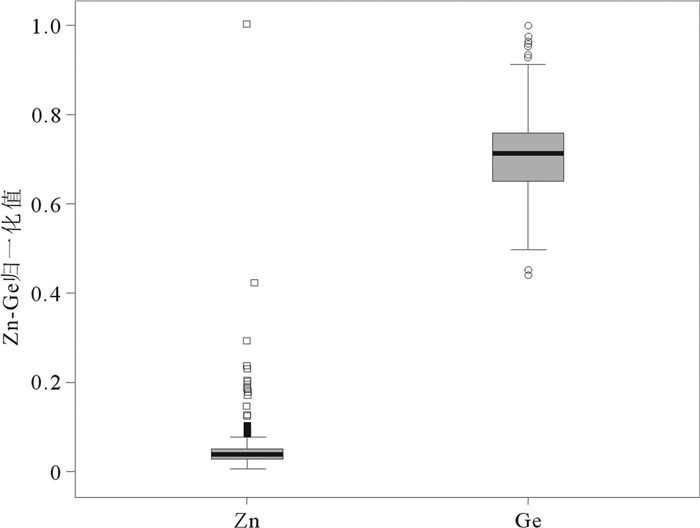
|
图 4 研究区水系沉积物Zn和Ge元素含量箱式图 Fig. 4 The box plots of Zn and Ge elements in stream sediments of studied area |
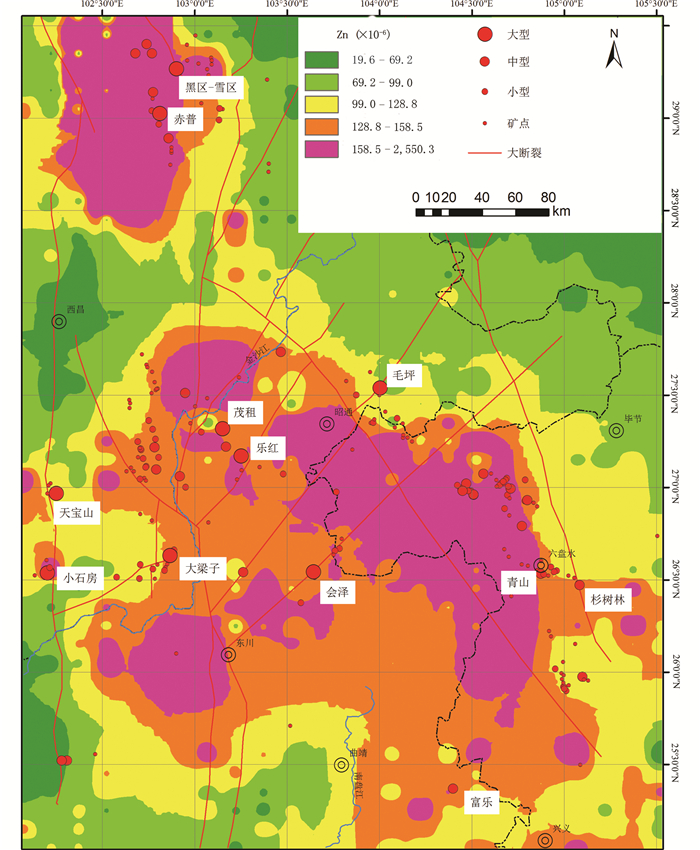
|
图 5 研究区水系沉积物Zn元素含量地球化学图 Fig. 5 The geochemical map of Zn element in stream sediments of studied area |
根据锗元素的统计直方图(图 2b)和Q-Q图(图 3b)可以看出其较为符合正态分布,且离散程度较小(变异系数=0.13),最大值与最小值之间差距很小,基本围绕地壳丰度值(1.6×10-6)(Höll et al., 2007)波动,这一点从箱式图也可以得到清晰的反映(图 4),且从直方图和Q-Q图上可以看出锗元素分布仅有一个峰值,表明锗元素分布仅由一个正态总体构成,难于划分为理想的背景和块体两个总体;另一方面,根据锗元素地球化学图与矿床(点)空间关系分布(图 6),可以看出锗元素值分布与矿床(点)之间并没有明显的对应关系,相对高值区有大梁子、会泽、乐红等矿床相叠加,而相对低值区有黑区-雪区和赤普相对应,在中等强度的区域有天宝山、小石房、茂租、毛坪、青山、杉树林、富乐等矿床产出,可进一步说明,锗元素的区域地球化学分布对锗矿床的分布没有控制和指示作用,采用锗元素圈定地球化学块体是没有依据的,不符合以锗找锗的区域化探找矿思路,必须另辟蹊径。
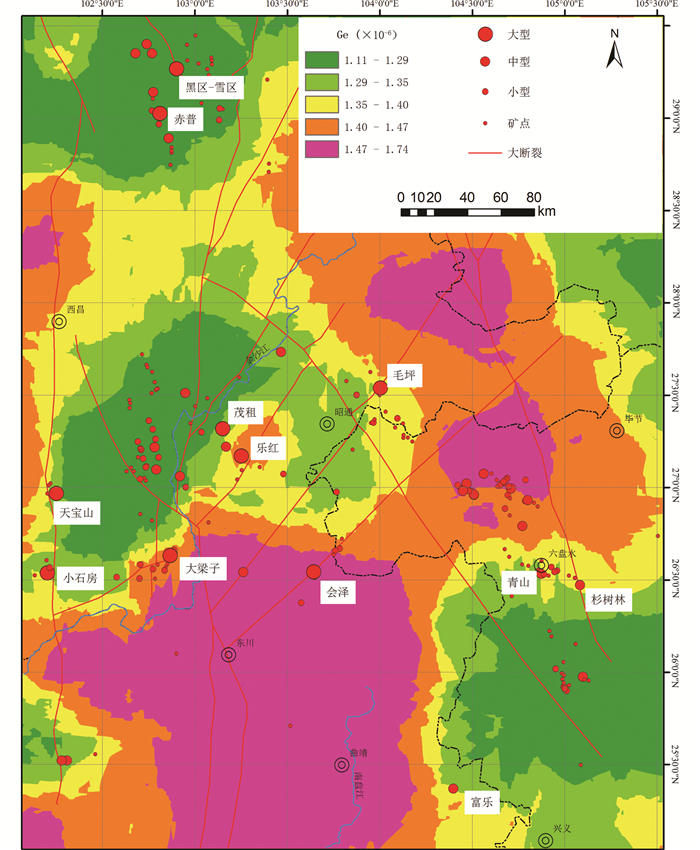
|
图 6 研究区Ge元素含量地球化学图 Fig. 6 The geochemical map of Ge element in stream sediments of studied area |
关于锗元素与锌元素的关系,前人已经做了大量研究,普遍认为在铅锌锗矿床中,原生状态下,锗主要以类质同象赋存在闪锌矿中,尤其是铁含量较低的浅色闪锌矿中(胡瑞忠等,2000;Höll et al., 2007;Cugerone et al., 2018)。然而,在表生氧化状态下,锗和锌是否还有如此紧密的共生关系,相关研究却很少见,尤其是由于锗元素的多亲和性(亲铁、亲硫、亲石、亲有机质)和高度分散性(刘英俊等,1984),使得在表生状态下锗与锌的共生分离关系研究显得尤为重要。本文通过以上水系沉积物中锗元素和锌元素的散点图(图 7)分析可知,他们之间几乎没有相关关系,因为相关系数很小,接近于0(R2=0.009 < < 0.8)。造成这种情况的原因可能是在表生氧化条件下,锗与锌表现出迥异的物理、化学性质而发生分离造成的。这一结果表明虽然锗与锌在原生条件下的紧密共生,但锗在表生条件下却表现出高度分散性和均匀性等截然不同的物理、化学特性,也进一步表明在寻找锗矿的问题上应该采用以锌找锗的区域化探找矿思路,即:首先通过锌元素化探异常发现铅锌矿床,然后通过综合评价铅锌矿床,尤其是其中主要的富锌矿体,进一步发现锗矿床,这也恰恰与前言中提到的已发现锗矿的勘查历史相一致。
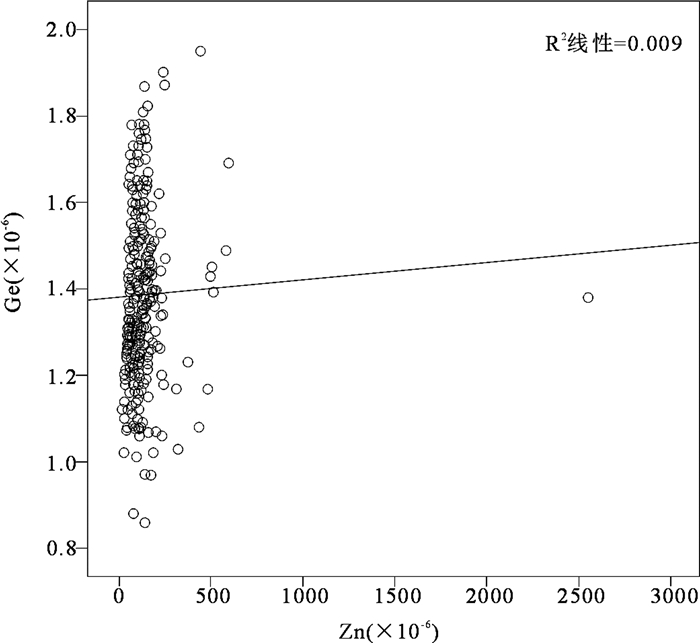
|
图 7 研究区水系沉积物Zn与Ge元素含量散点图 Fig. 7 The scatter diagram between Zn element and Ge element in stream sediments of studied area |
在确立了以锌找锗的找矿思路之后,如何确定锌地球化学块体的范围是进一步圈定找矿远景区的当务之急。前人在研究确定异常下限的研究方面,做了大量的工作,但主要分为2类,一类是基于经典统计分析的异常下限确定方法;另一类是近些年来新发展起来的基于多重分形理论的异常圈定方法,该类方法强调不同总体的科学分离。本文通过采用经典统计学方法,包括:直方图法(均值+2倍标准差)、箱式图法(中值[xi]+2中值[|xi-中值[xi]|])、累计概率法(累计分布概率为80%)、原生晕法(原生晕外带,相当于边界品位的1/80)圈定的锌地球化学块体下限分别为392.7×10-6、153.9×10-6、87.5×10-6和146.5×10-6;而采用先进的基于多重分形理论的C-A方法确定的地球化学块体下限为124×10-6。
通过定性分析不同方法圈定的地球化学块体与矿床(点)之间的空间关系来看:直方图法(图 8)圈定的地球化学块体明显偏小,研究区仅有8个矿床产出在该块体内,仅占矿床总数的3.8%,尤其是绝大多数规模矿床并没有出现在地球化学块体内,因此明显是不合适的;原生晕法(图 9)圈定的地球化学块体的范围又明显偏大,虽然涵盖了绝大多数矿床(204个),占矿床总数的97.0%,但也能够明显看出将大面积的空白区也圈定为地球化学块体,因此也是不合理的。累计概率法(图 10)、箱式图法(图 11)和C-A方法(图 12)相对以上两种方法从地球化学块体与矿床(点)的定性关系上看要显得合理的多,但要确定哪种方法是最优方法,还需要采用更为精确的定量方法进一步验证。本文采用证据权模型提供的相关系数(C)的学生氏统计量(t)来度量地球化学块体的最优下限区间,通过计算,当C=1.98时,其所对应的统计量t=9.42时达到最大值,对应的第20个元素区间范围为120×10-6~130×10-6(图 13、表 2),落在该区间的异常下限仅仅包含基于多重分形理论的C-A方法所确定的下限,因此可以确认124×10-6是最合理的异常下限,此时,落在地球化学块体内的矿床数为189个,占总数的85.6%,该值确定的地球化学块体将作为进一步圈定找矿远景区的基础。
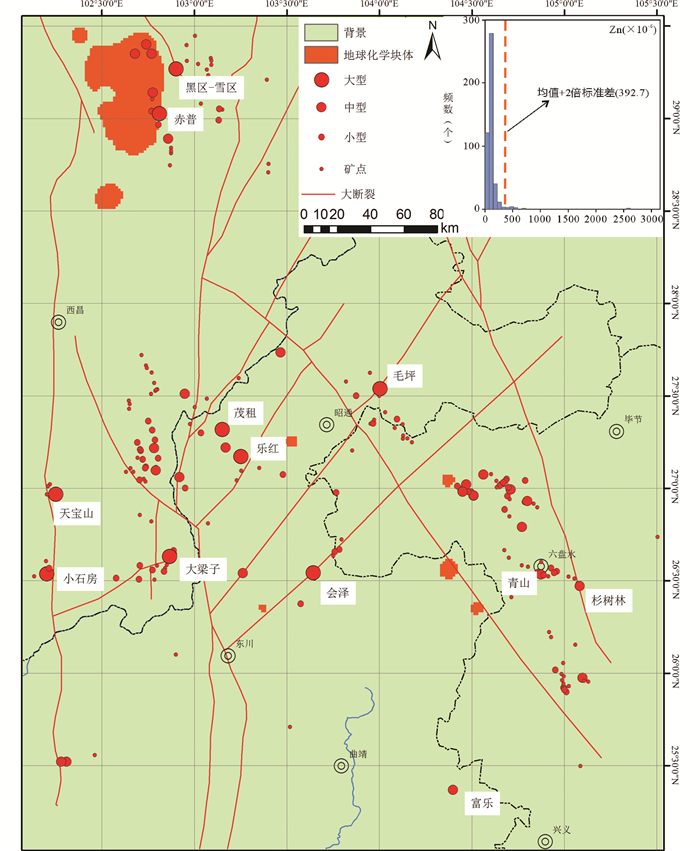
|
图 8 直方图法(元素均值+2×标准差为异常下限)圈定研究区的Zn地球化学块体 Fig. 8 Geochemical blocks delineated by using the Zn element's value corresponding to the histogram (mean+2×standard deviation) in studied area |
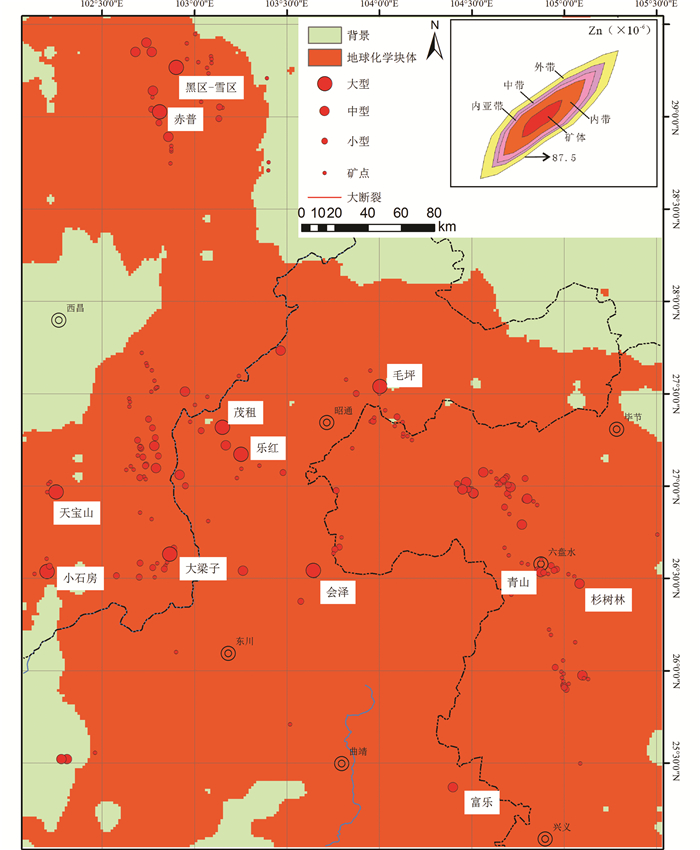
|
图 9 原生晕法(原生晕外带下限作为异常下限)圈定研究区的Zn地球化学块体 Fig. 9 Geochemical blocks delineated by using the Zn element's value corresponding to that of outer zone of primary halo in studied area |
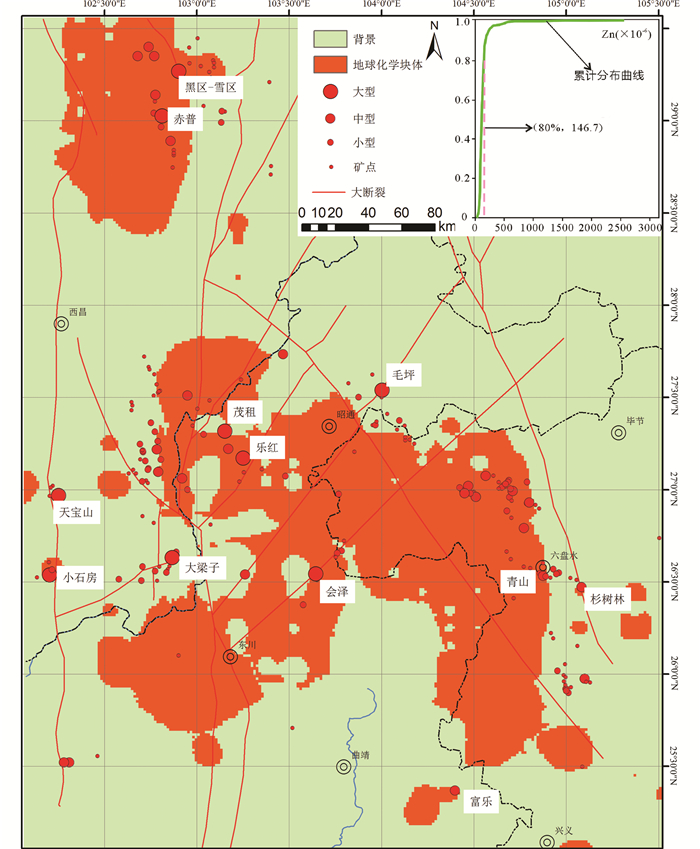
|
图 10 累计概率法(累计分布概率的80%对应元素值确定异常下限)圈定研究区的Zn地球化学块体 Fig. 10 Geochemical blocks delineated by using the Zn element's value corresponding to the cumulative probability (80%) from probability cumulative curve in studied area |
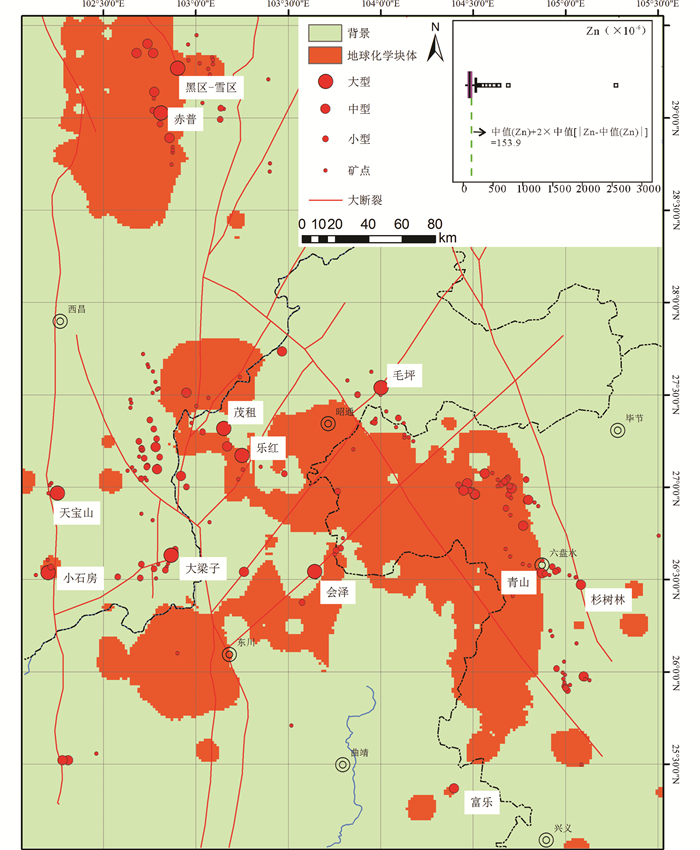
|
图 11 元素箱式图法(中值[Zn]+2×中值[|Zn-中值[Zn]|]确定异常下限)圈定研究区的Zn地球化学块体 Fig. 11 Geochemical blocks delineated by using the Zn element's value corresponding to the box plot (median[Zn]+2×median[|Zn-median[Zn]|] in studied area |
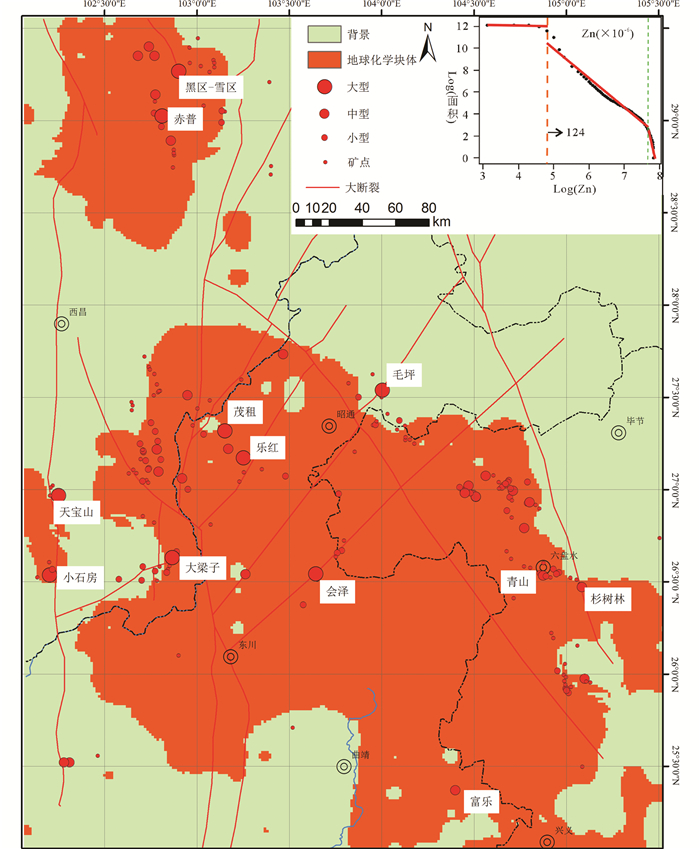
|
图 12 C-A方法确定异常下限圈定研究区的Zn地球化学块体 Fig. 12 Geochemical blocks delineated by using C-A method in studied area |

|
图 13 证据权法确定研究区的Zn地球化学块体下限范围 Fig. 13 The interval of lower limit of Zn geochemical blocks delineated by using weights of evidence model in studied area |
|
|
表 2 证据权法计算的锌元素的权重、相关性系数及它们的标准差和统计量 Table 2 Weights, contrasts and their standard deviations for Zn element |
在以上地球化学块体圈定的基础上(图 12),结合矿床主要赋存在震旦系至下二叠统的碳酸盐岩中,且在区域上受不同层次的断裂以及层间破碎带控制(图 1),并综合考虑共伴生元素(Pb、Ag)的空间分布(图 14、图 15);另外基于受构造控制的矿床分布往往具有“丛聚效应”与“鹤立鸡群”的特点(金友渔,1984;王世称等,2000;郭涛和吕古贤,2007;成秋明等,2009;张遵遵等,2013),进而圈定了黑区-赤普(Ⅰ)、大湾子-大桥边(Ⅱ)、茂租-乐红(Ⅲ)、毛坪(Ⅳ)、天宝山-小石房(Ⅴ)、猫猫厂-白蜡厂(Ⅵ)、大梁子(Ⅶ)、会泽(Ⅷ)、青山-杉树林(Ⅸ)、猴子厂-顶头山(Ⅹ)以及富乐(Ⅺ)等11处矿田级找矿远景区(图 16)。这为进一步的地质找矿工作部署提供依据。
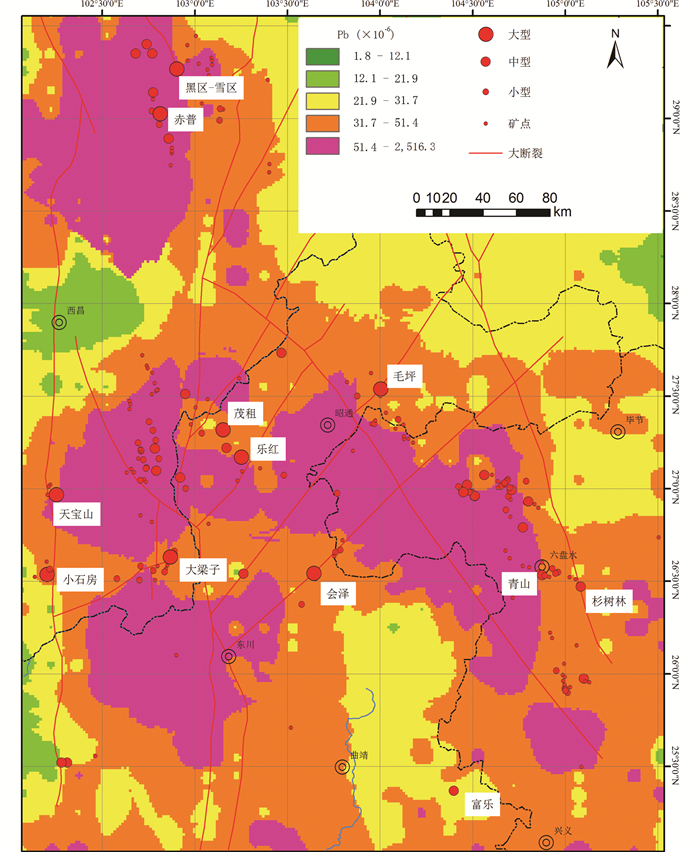
|
图 14 研究区水系沉积物Pb元素含量地球化学图 Fig. 14 The geochemical map of Pb element in stream sediments of studied area |
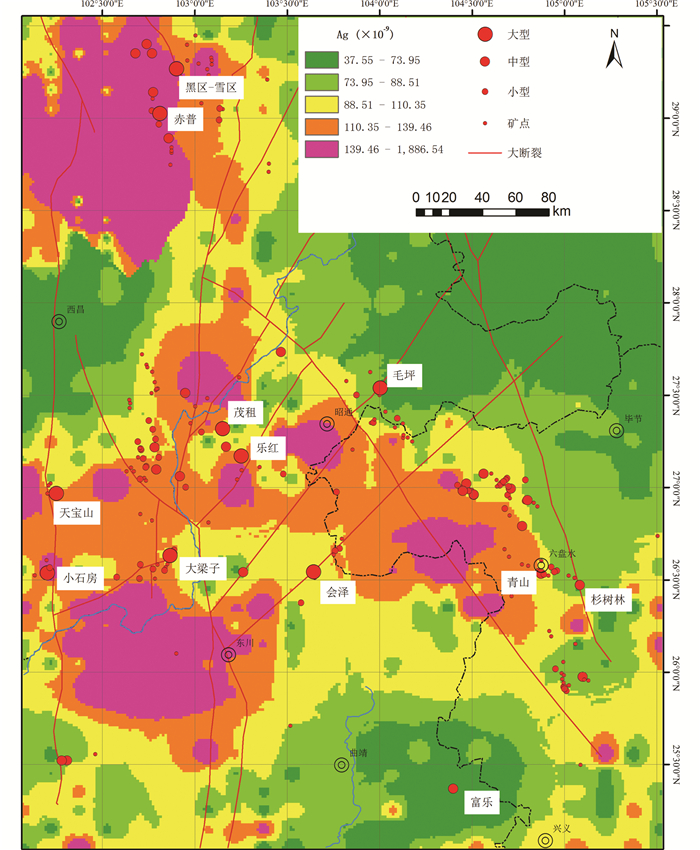
|
图 15 研究区水系沉积物Ag元素含量地球化学图 Fig. 15 The geochemical map of Ag element in stream sediments of studied area |
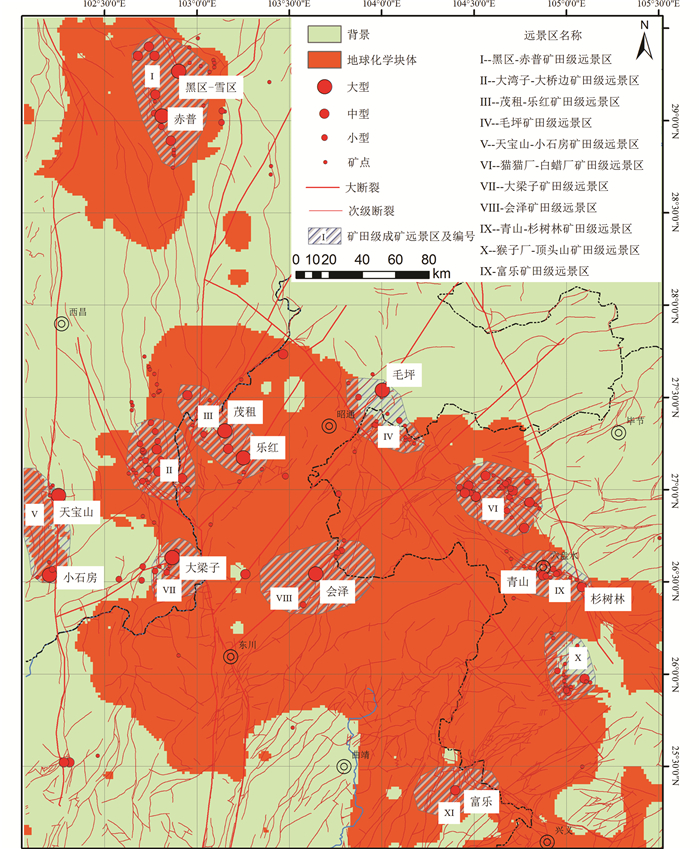
|
图 16 研究区矿田级找矿远景区分布图 Fig. 16 The map of ore-field level tracts in studied area |
(1) 在川滇黔地区采用区域化探方法寻找锗矿时,以锗找锗的直接方法是行不通的,而这可能是由于Ge在表生氧化状态的多亲和性和高度分散性造成的,因此需要采用以锌找锗的间接方法来寻找锗矿;
(2) 通过采用多种方法定性比较以及证据权模型定量验证表明,基于多重分形理论的C-A方法在圈定地球化学块体方面是独具优势的,这可能是其不仅考虑了频数特征,还考虑了空间几何特征的原因;
(3) 基于所圈定的地球化学块体,结合热液矿床受构造(断层或层间破碎带)控制及其它共伴生元素分布特征,且矿床往往具有“丛聚效应”以及“鹤立鸡群”的特点,圈定了黑区-赤普、大湾子-大桥边、茂租-乐红、毛坪、天宝山-小石房、猫猫厂-白蜡厂、大梁子、会泽、青山-杉树林、猴子厂-顶头山以及富乐等11个矿田级远景区作为寻找锗矿的潜力区。
致谢 本文的完成得到了中国地质调查中心程志中教授级高工、左群超教授级高工的大力支持;两位匿名审稿人提出了许多宝贵的建议,提升了文章的质量;在此一并表示衷心的感谢!
Agterberg FP. 1989. Computer programs for mineral exploration. Science, 245(4913): 76-81 DOI:10.1126/science.245.4913.76 |
Alexandre C, Bénédicte C, Alain C, Elisabeth LG, Laurent B, Olivier A and Mael A. 2018. Relationships between the occurrence of accessory Ge-minerals and sphalerite in Variscan Pb-Zn deposits of the Bossost anticlinorium, French Pyrenean axial zone:Chemistry, microstructures and ore-deposit setting. Ore Geology Reviews, 95: 1-19 DOI:10.1016/j.oregeorev.2018.02.016 |
Asadi HH, Kianpouryan S, Lu YJ and McCuaig TC. 2014. Exploratory data analysis and C-A fractal model applied in mapping multi-element soil anomalies for drilling:A case study from the Sari Gunay epithermal gold deposit, NW Iran. Journal of Geochemical Exploration, 145: 233-241 DOI:10.1016/j.gexplo.2014.07.005 |
Bonham-Carter GF, Agterberg FP and Wright DF. 1989. Weights of evidence modelling: A new approach to mapping mineral potential. In: Agterberg FP and Bonham-Carter GF (eds.). Statistical Applications in the Earth. Canada: Geological Survey of Canada, 171-183
|
Carranza EJM. 2009. Geochemical Anomaly and Mineral Prospectivity Mapping in GIS. Handbook of Exploration and Environmental Geochemistry, 11. London: Elsevier: 1-351
|
Carranza EJM. 2010. Catchment basin modeling of stream sediment anomalies revisited:Incorporation of EDA and fractal analysis. Geochemistry:Exploration, Environment, Analysis, 10(4): 365-381 DOI:10.1144/1467-7873/09-224 |
Chen D and Liu Y. 2012. Discussion on the relationships between Emeishan basalt and Pb-Zn mineralization. Mineral Exploration, 3(4): 469-475 (in Chinese with English abstract) |
Cheng QM, Agterberg FP and Ballantyne SB. 1994. The separation of geochemical anomalies from background by fractal methods. Journal of Geochemical Exploration, 51(2): 109-130 DOI:10.1016/0375-6742(94)90013-2 |
Cheng QM, Zhao PD, Zhang SY, Xia QL, Chen ZJ, Chen JG, Xu DY and Wang WL. 2009. Application of singularity theory in prediction of tin and copper mineral deposits in Gejiu district, Yunnan, China:Information integration and delineation of mineral exploration targets. Earth Science (Journal of China University of Geosciences), 34(2): 243-252 (in Chinese with English abstract) DOI:10.3799/dqkx.2009.022 |
Cheng ZZ, Xie XJ, Feng JZ, Zhang Q, Yao WS and Fang JD. 2014. Geochemical Atlas of South China. Beijing: Geological Publishing House: 1-113 (in Chinese)
|
Cugerone A, Cenki-Tok B, Chauvet A, Le Goff E, Bailly L, Alard O and Allard M. 2018. Relationships between the occurrence of accessory Ge-minerals and sphalerite in Variscan Pb-Zn deposits of the Bossost anticlinorium, French Pyrenean Axial Zone:Chemistry, microstructures and ore-deposit setting. Ore Geology Reviews, 95: 1-19 DOI:10.1016/j.oregeorev.2018.02.016 |
Doe BR. 1991. Source rock and the genesis of metallic deposits. Global Tectonics and Metallogeny, 4(1-2): 13-19 DOI:10.1127/gtm/4/1991/13 |
Gu SY. 2006. Characteristics of rare-earth elements composition within lead-zinc deposits in northwestern Guizhou:In addition to a discussion of relationship between lead-zinc deposits and Emeishan basalts in northwestern Guizhou. Guizhou Geology, 23(4): 274-277 (in Chinese with English abstract) |
Guo T and Lü GX. 2007. System analysis of ore-controlling structure in the northwestern Jiaodong gold metallogenic belt. Journal of Geomechanics, 13(2): 119-130 (in Chinese with English abstract) |
Han RS, Chen J, Wang F, Wang XK and Li Y. 2015. Analysis of metal-element association halos within fault zones for the exploration of concealed ore-bodies:A case study of the Qilinchang Zn-Pb-(Ag-Ge) deposit in the Huize mine district, northeastern Yunnan, China. Journal of Geochemical Exploration, 159: 62-78 DOI:10.1016/j.gexplo.2015.08.006 |
He CZ, Xiao CY, Wen HJ, Zhou T, Zhu CW and Fan HF. 2016. Zn-S isotopic compositions of the Tianbaoshan carbonate-hosted Pb-Zn deposit in Sichuan, China:Implications for source of ore components. Acta Petrologica Sinica, 32(11): 3394-3406 (in Chinese with English abstract) |
Höll R, Kling M and Schroll E. 2007. Metallogenesis of germanium:A review. Ore Geology Reviews, 30(3-4): 145-180 DOI:10.1016/j.oregeorev.2005.07.034 |
Hu RZ, Bi XW, Su WC and Ye ZJ. 1997. Some considerations on germanium mineralization in coal:As exemplified by Lincang germanium deposit. Acta Mineralogica Sinica, 17(4): 364-368 (in Chinese with English abstract) |
Hu RZ, Su WC, Qi HW and Bi XW. 2000. Geochemistry, occurrence and mineralization of germanium. Bulletin of Mineralogy, Petrology and Geochemisty, 19(4): 215-217 (in Chinese) |
Hu RZ and Zhou MF. 2012. Multiple Mesozoic mineralization events in South China:An introduction to the thematic issue. Mineralium Deposita, 47(6): 579-588 DOI:10.1007/s00126-012-0431-6 |
Hu RZ, Chen WT, Xu DR and Zhou MF. 2017a. Reviews and new metallogenic models of mineral deposits in South China:An introduction. Journal of Asian Earth Sciences, 137: 1-8 DOI:10.1016/j.jseaes.2017.02.035 |
Hu RZ, Fu SL, Huang Y, Zhou MF, Fu SH, Zhao CH, Wang YJ, Bi XW and Xiao JF. 2017b. The giant South China Mesozoic low-temperature metallogenic domain:Reviews and a new geodynamic model. Journal of Asian Earth Sciences, 137: 9-34 DOI:10.1016/j.jseaes.2016.10.016 |
Hu YG, Li CY, Wen HJ and Huang ZL. 2000. A study on mineral characteristics of Ag in Pb-Zn-Ag deposits in Sichuan, Yunnan and Guizhou provinces, China. Bulletin of Mineralogy, Petrology and Geochemisty, 19(4): 318-320 (in Chinese) |
Huang ZL, Chen J, Liu CQ, Han RS, Li WB, Zhao DS, Gao DR and Feng ZH. 2001. A preliminary discussion on the genetic relationship between Emeishan basalts and Pb-Zn deposits as exemplified by the Huize Pb-Zn deposit, Yunnan Province. Acta Mineralogica Sinica, 21(4): 681-688 (in Chinese with English abstract) |
Jin YY. 1984. The mathematical model of enriched mineralization center and its application to the prediction of the total amount of mineral resources. Earth Science (Journal of Wuhan College of Geology), (4): 117-124 (in Chinese with English abstract) |
Li B, Gu XC, Wen SM, Han RS, Sheng R, Xu GD, Cao Y, Wu H and Zou GF. 2012. Effect of Emeishan basalt in Northeast Yunnan on lead and zinc mineralization. Mineral Resources and Geology, 26(2): 95-100 (in Chinese with English abstract) |
Li K, Liu K, Tang CY and Duan QF. 2013. Characteristics of zinc geochemical blocks and assessment of zinc resource potential in western Hunan and eastern Guizhou provinces. Geology in China, 40(4): 1270-1277 (in Chinese with English abstract) |
Li SM, Wu JX, Luan WL, Wei MH and Chen SQ. 2009. The application of geochemical block method to gold resource assessment in northern Hebei Province. Geology in China, 36(2): 444-449 (in Chinese with English abstract) |
Li T, Yuan HY, Wu SX and Cheng XF. 1996. Regional element abundances of continental crust bodies in China. Geotectonica et Metallogenia, 23(2): 101-107 (in Chinese with English abstract) |
Li WB, Huang ZL, Chen J, Han RS, Guan T, Xu C, Gao DR and Zhao DS. 2002. Sources of ore-forming materials in Huize superlarge zinc-lead deposit, Yunnan Province:Evidence from contents of ore-forming element in strata and basalts from margin of ore district. Mineral Deposits, 21(Suppl.): 413-416 (in Chinese with English abstract) |
Li WB, Huang ZL and Zhang G. 2006. Sources of the ore metals of the Huize ore field in Yunnan Province:Constraints from Pb, S, C, H, O and Sr isotope geochemistry. Acta Petrologica Sinica, 22(10): 2567-2580 (in Chinese with English abstract) |
Liang F, Bi XW, Feng CX, Tang YY, Wei DX and Dai ZH. 2016. Mineralogical and geochemical characteristics of carbonate and implications for ore-forming mechanism of the Fule Pb-Zn deposit, Yunnan Province, China. Acta Petrologica Sinica, 32(11): 3418-3430 (in Chinese with English abstract) |
Liu HC. 1995. Emeishan basalt and Pb-Zn metallogenesis. Geology and Exploration, 31(4): 1-6 (in Chinese with English abstract) |
Liu WZ and Xu XH. 1996. On the relationship between the deposits and tectonics of the Sichuan-Yuanan-Guizhou Pb-Zn mineralized belt. Journal of Chengdu University of Technology, 23(1): 71-77 (in Chinese with English abstract) |
Liu YJ, Cao LM, Li ZL, Wang HN, Chu TQ and Zhang JR. 1984. Geochemistry of Element. Beijing: Science Press: 1-548 (in Chinese)
|
Lou DB, Xiao KY, Zuo RG and Ding JH. 2012. The application of fractal filtering technique to the study of the Huangshan-Jing'erquan Ni-Cu metallogenic belt, Xinjiang. Acta Geoscientica Sinica, 33(1): 83-90 (in Chinese with English abstract) |
Ou JX. 1996. Geological characteristics and ore-control geological conditions of Qingshan lead-zinc deposit, Guizhou. Journal of Guilin Institute of Technology, 16(3): 277-282 (in Chinese with English abstract) |
Shao Y. 1997. Lithogeochemical Survey (Primary Halo Method) for Hydrothermal Ore Deposit. Beijing: Geological Publishing House: 1-143 (in Chinese)
|
Si RJ, Gu XX, Xie LX and Zhang N. 2013. Geological characteristics of the Fule polymetallic deposit in Yunnan Province:A Pb-Zn deposit with dispersed elements and unusual enrichment. Geology and Exploration, 49(2): 313-322 (in Chinese with English abstract) |
The Editorial Committee of "The Discovery of Mineral Deposits of China:Volume of Guangxi". 1996. The Discovery History of Mineral Deposits of China:Volume of Guangxi. Beijing: Geological Publishing House: 1-173 (in Chinese)
|
The Editorial Committee of "The Discovery of Mineral Deposits of China:Volume of Hubei Province". 1996. The Discovery History of Mineral Deposits of China:Volume of Hubei Province. Beijing: Geological Publishing House: 1-175 (in Chinese)
|
Tu GC, Gao ZM, Hu RZ, Zhang Q, Li CY, Zhao ZH and Zhang BG. 2004. The Geochemistry and Ore-Forming Mechanism of the Dispersed Elements. Beijing: Geological Publishing House: 1-24 (in Chinese)
|
Wang SC, Chen YL and Xia LX. 2000. Theory and Method of Synthetic Information Mineral Resources Prognosis. Beijing: Science Press: 1-200 (in Chinese)
|
Wang TH, Huang WH, Yan DY and Tang XY. 2016. Progress of research on mineralization mode of large coal-Ge deposits in China:Coal-Ge deposit in Wulantuga of Inner Mongolia and Lincang of Yunan. Earth Science Frontiers, 23(3): 113-123 (in Chinese with English abstract) |
Wang XQ, Shen WJ, Zhang BM, Nie LS, Chi QH and Xu SF. 2007. Relationship of geochemical blocks and ore districts:Examples from Eastern Tianshan metallogenic belt, Xinjiang, China. Earth Science Frontiers, 14(5): 116-123 (in Chinese with English abstract) DOI:10.1016/S1872-5791(07)60040-2 |
Wang XQ, Zhang BM, Lin X, Xu SF, Yao WS and Ye R. 2016. Geochemical challenges of diverse regolith-covered terrains for mineral exploration in China. Ore Geology Reviews, 73: 417-431 DOI:10.1016/j.oregeorev.2015.08.015 |
Xie JB and Jin YJ. 2009. Issues on the exploratory data analysis of complex survey data. Statistics & Information Forum, 24(7): 13-17, 56 (in Chinese with English abstract) |
Xie XJ. 1995. New concept and new technique in searching for giant ore deposits. Scientific Chinese, (5): 15-16, 14 (in Chinese) |
Xie XJ and Xiang YC. 1999. The geochemical prediction methodology of giant ore deposits. In:Xie XJ, Shao Y and Wang QX (eds.). The Exploration Geochemistry into 21st Century. Beijing: Geological Publishing House: 61-91 (in Chinese)
|
Xie XJ and Cheng HX. 2014. Sixty years of exploration geochemistry in China. Journal of Geochemical Exploration, 139: 4-8 DOI:10.1016/j.gexplo.2013.06.013 |
Xue BG. 2004. The approach of the geologic characteristic and the origin of the associated (coexited) Ge ore in the northeastward in Yunnan Province. Geology of Chemical Minerals, 26(4): 210-219, 227 (in Chinese with English abstract) |
Yang B, Jin CH, Zhang Y, Ji PL, Guo Y and Wang ZZ. 2018. Ore deposit characteristics and metallogenic model of the Maoping Pb-Zn deposit in Wumengshan Mountainous area, Yunnan Province. Acta Geoscientica Sinica, 39(5): 593-605 (in Chinese with English abstract) |
Yang Q, Zhang J, Wang J, Zhong WB and Liu WH. 2017. Study of ore-forming fluid geochemistry of Maozu large-scale lead-zinc deposit in Northeast Yunnan. Mineral Resources and Geology, 31(5): 854-863 (in Chinese with English abstract) |
Yang SP, Bao GP, Lan AP, Lu MD, Xu L, Huang L and An Q. 2018. Geochemical characteristics of trace elements and rare earth elements in sulfides from the Shanshulin Pb-Zn deposit, NW Guizhou, China and their geological significances. Acta Mineralogica Sinica, 38(6): 600-609 (in Chinese with English abstract) |
Ye L, Li ZL, Hu YS, Huang ZL, Zhou JX, Fan HF and Danyushevskiy L. 2016. Trace elements in sulfide from the Tianbaoshan Pb-Zn deposit, Sichuan Province, China:A LA-ICPMS study. Acta Petrologica Sinica, 32(11): 3377-3393 (in Chinese with English abstract) |
Yuan B, Mao JW, Yan XH, Wu Y, Zhang F and Zhao LL. 2014. Sources of metallogenic materials and metallogenic mechanism of Daliangzi ore field in Sichuan Province:Constraints from geochemistry of S, C, H, O, Sr isotope and trace element in sphalerite. Acta Petrologica Sinica, 30(1): 209-220 (in Chinese with English abstract) |
Zhang CQ, Mao JW, Wu SP, Li HM, Liu F, Guo BJ and Gao DR. 2005. Distribution, characteristics and genesis of Mississippi Valley-Type lead-zinc deposits in Sichuan-Yunnan-Guizhou area. Mineral Deposits, 24(3): 336-348 (in Chinese with English abstract) |
Zhang X. 2013. Exploratory data analysis applied in the average wages of staff and workers. China Market Marketing, (46): 99-100 (in Chinese) |
Zhang Y, Diao KS and Zhang L. 2016. The hydrothermal alteration feature of Maoping Pb-Zn deposit in Yiliang, Yunnan. Yunnan Geology, 35(1): 49-54 (in Chinese with English abstract) |
Zhang YX, Zhu CW, Fu SH, Zhou GF, Qin YR, Fan HF and Wen HJ. 2012. A study on the enrichment regularity of dispersed elements Ge in Pb-Zn deposits in Sichuan, Yunnan and Guizhou provinces, China. Acta Mineralogica Sinica, 32(1): 60-64 (in Chinese with English abstract) |
Zhang ZZ, Li ZQ, Wang JZ, Hu T and Hou CQ. 2013. Characteristics of lead-zinc deposits in Gangdise metallogenic belt, Tibet, China. Contributions to Geology and Mineral Resources Research, 28(1): 34-40 (in Chinese with English abstract) |
Zheng CL. 1992. The relationship between carbonate turbidite and mineralization of the Shanshulin lead-zinc deposit, Guizhou. Journal of Guilin College of Geology, 12(4): 323-334 (in Chinese with English abstract) |
Zhou D, Chen YQ and Zhao BB. 2014. The application of singular-value decomposition (SVD) and geochemical blocks methods to the prospecting in southern Huanggang-Ganzhu'ermiao metallogenic belt. Geology in China, 41(2): 621-637 (in Chinese with English abstract) |
Zhou JX, Huang ZL, Gao JG and Wang T. 2012. Sources of ore-forming metals and fluids, and mechanism of mineralization, Maozu large carbonate-hosted lead-zinc deposit, Northeast Yunnan Province. Journal of Mineralogy and Petrology, 32(3): 62-69 (in Chinese with English abstract) |
Zhou Q, Du F and Du B. 2017. A preliminary analysis on the feature and genesis of Daqingshan Pb-Zn deposit in NE Yunnan. Yunnan Geology, 36(1): 51-54 (in Chinese with English abstract) |
Zhou SG, Zhou KF, Cui Y, Wang JL and Ding JL. 2015. Exploratory data analysis and singularity mapping in geochemical anomaly identification in Karamay, Xinjiang, China. Journal of Geochemical Exploration, 154: 171-179 DOI:10.1016/j.gexplo.2014.12.007 |
陈大, 刘义. 2012. 峨眉山玄武岩与铅锌成矿作用关系探讨. 矿产勘查, 3(4): 469-475. DOI:10.3969/j.issn.1674-7801.2012.04.011 |
成秋明, 赵鹏大, 张生元, 夏庆霖, 陈志军, 陈建国, 徐德义, 王文磊. 2009. 奇异性理论在个旧锡铜矿产资源预测中的应用:综合信息集成与靶区圈定. 地球科学-中国地质大学学报, 34(2): 243-252. DOI:10.3321/j.issn:1000-2383.2009.02.003 |
程志中, 谢学锦, 冯济舟, 张勤, 姚文生, 方金东. 2014. 中国南方地区地球化学图集. 北京: 地质出版社: 1-113.
|
顾尚义. 2006. 黔西北铅锌矿稀土元素组成特征——兼论黔西北地区铅锌矿成矿与峨眉山玄武岩的关系. 贵州地质, 23(4): 274-277. DOI:10.3969/j.issn.1000-5943.2006.04.006 |
郭涛, 吕古贤. 2007. 胶东西北部金成矿带控矿构造系统分析. 地质力学学报, 13(2): 119-130. DOI:10.3969/j.issn.1006-6616.2007.02.005 |
何承真, 肖朝益, 温汉捷, 周汀, 朱传威, 樊海峰. 2016. 四川天宝山铅锌矿床的锌-硫同位素组成及成矿物质来源. 岩石学报, 32(11): 3394-3406. |
胡瑞忠, 毕献武, 苏文超, 叶造军. 1997. 对煤中锗矿化若干问题的思考——以临沧锗矿为例. 矿物学报, 17(4): 364-368. DOI:10.3321/j.issn:1000-4734.1997.04.002 |
胡瑞忠, 苏文超, 戚华文, 毕献武. 2000. 锗的地球化学、赋存状态和成矿作用. 矿物岩石地球化学通报, 19(4): 215-217. |
胡耀国, 李朝阳, 温汉捷, 黄智龙. 2000. 川滇黔接壤处铅锌银矿床中银矿物特征. 矿物岩石地球化学通报, 19(4): 318-320. |
黄智龙, 陈进, 刘丛强, 韩润生, 李文博, 赵德顺, 高德荣, 冯志宏. 2001. 峨眉山玄武岩与铅锌矿床成矿关系初探——以云南会泽铅锌矿床为例. 矿物学报, 21(4): 681-688. |
金友渔. 1984. 矿化富集中心的数学模型及在矿产资源总量预测中的应用. 地球科学-武汉地质学院学报, (4): 117-124. |
李堃, 刘凯, 汤朝阳, 段其发. 2013. 湘西黔东地区Zn地球化学块体特征及锌资源潜力估算. 中国地质, 40(4): 1270-1277. |
李波, 顾晓春, 文书明, 韩润生, 盛蕊, 徐国端, 曹宇, 吴昊, 邹国富. 2012. 滇东北地区峨眉山玄武岩在铅锌成矿中的作用. 矿产与地质, 26(2): 95-100. |
李随民, 吴景霞, 栾文楼, 魏明辉, 陈树清. 2009. 地球化学块体方法在冀北金矿资源潜力估算中的应用. 中国地质, 36(2): 444-449. |
黎彤, 袁怀雨, 吴胜昔, 程先富. 1996. 中国大陆壳体的区域元素丰度. 大地构造与成矿学, 23(2): 101-107. |
李文博, 黄智龙, 陈进, 韩润生, 管涛, 许成, 高德荣, 赵德顺. 2002. 云南会泽超大型铅锌矿床成矿物质来源——来自矿区外围地层及玄武岩成矿元素含量的证据. 矿床地质, 21(增): 413-416. |
李文博, 黄智龙, 张冠. 2006. 云南会泽铅锌矿田成矿物质来源:Pb、S、C、H、O、Sr同位素制约. 岩石学报, 22(10): 2567-2580. |
梁峰, 毕献武, 冯彩霞, 唐永永, 韦东晓, 戴智慧. 2016. 云南富乐铅锌矿床碳酸盐矿物化学特征及其对成矿作用的指示. 岩石学报, 32(11): 3418-3430. |
柳贺昌. 1995. 峨眉山玄武岩与铅锌成矿. 地质与勘探, 31(4): 1-6. |
刘文周, 徐新煌. 1996. 论川滇黔铅锌成矿带矿床与构造的关系. 成都理工学院学报, 23(1): 71-77. |
刘英俊, 曹励明, 李兆麟, 王鹤年, 储同庆, 张景荣. 1984. 元素地球化学. 北京: 科学出版社: 1-548.
|
娄德波, 肖克炎, 左仁广, 丁建华. 2012. 分形滤波技术在新疆黄山-镜儿泉镍铜成矿带中的应用. 地球学报, 33(1): 83-90. |
欧锦秀. 1996. 贵州水城青山铅锌矿床的成矿地质特征. 桂林工学院学报, 16(3): 277-282. |
邵跃. 1997. 热液矿床岩石测量(原生晕法)找矿. 北京: 地质出版社: 1-143.
|
司荣军, 顾雪祥, 谢良鲜, 张娜. 2013. 云南省富乐分散元素多金属矿床地质特征——一个分散元素超常富集的铅锌矿床. 地质与勘探, 49(2): 313-322. |
涂光炽, 高振敏, 胡瑞忠, 张乾, 李朝阳, 赵振华, 张宝贵. 2004. 分散元素地球化学及成矿机制. 北京: 地质出版社: 1-424.
|
王世称, 陈永良, 夏立显. 2000. 综合信息矿产预测理论与方法. 北京: 科学出版社: 1-200.
|
王学求, 申伍军, 张必敏, 聂兰仕, 迟清华, 徐善法. 2007. 地球化学块体与大型矿集区的关系——以东天山为例. 地学前缘, 14(5): 116-123. |
王婷灏, 黄文辉, 闫德宇, 唐修义. 2016. 中国大型煤-锗矿床成矿模式研究进展:以云南临沧和内蒙古乌兰图嘎煤-锗矿床为例. 地学前缘, 23(3): 113-123. |
谢佳斌, 金勇进. 2009. 探索性数据分析中的统计图形应用. 统计与信息论坛, 24(7): 13-17, 56. |
谢学锦. 1995. 用新观念与新技术寻找巨型矿床. 科学中国人, (5): 15-16, 14. |
谢学锦, 向运川. 1999.巨型矿床的地球化学预测方法.见: 谢学锦, 邵跃, 王学求编.走向21世纪矿产勘查地球化学.北京: 地质出版社, 61-91
|
薛步高. 2004. 滇东北伴(共)生锗矿地质特征及成因探讨. 化工矿产地质, 26(4): 210-219, 227. |
杨斌, 金灿海, 张玙, 冀盘龙, 郭阳, 王子正. 2018. 云南乌蒙山区毛坪铅锌矿矿床特征及成矿模式研究. 地球学报, 39(5): 593-605. |
杨清, 张均, 王健, 仲文斌, 刘文浩. 2017. 滇东北茂租大型铅锌矿床成矿流体地球化学研究. 矿产与地质, 31(5): 854-863. |
杨松平, 包广萍, 兰安平, 卢贸达, 徐磊, 黄林, 安琦. 2018. 黔西北杉树林铅锌矿床微量和稀土元素地球化学特征及其地质意义. 矿物学报, 38(6): 600-609. |
叶霖, 李珍立, 胡宇思, 黄智龙, 周家喜, 樊海峰, Danyushevskiy L. 2016. 四川天宝山铅锌矿床硫化物微量元素组成:LA-ICPMS研究. 岩石学报, 32(11): 3377-3393. |
袁波, 毛景文, 闫兴虎, 吴越, 张锋, 赵亮亮. 2014. 四川大梁子铅锌矿成矿物质来源与成矿机制:硫、碳、氢、氧、锶同位素及闪锌矿微量元素制约. 岩石学报, 30(1): 209-220. |
《中国矿床发现史·广西卷》编委会. 1996. 中国矿床发现史·广西卷. 北京: 地质出版社: 1-173.
|
《中国矿床发现史·湖北卷》编委会. 1996. 中国矿床发现史·湖北卷. 北京: 地质出版社: 1-175.
|
张长青, 毛景文, 吴锁平, 李厚民, 刘峰, 郭保健, 高德荣. 2005. 川滇黔地区MVT铅锌矿床分布、特征及成因. 矿床地质, 24(3): 336-348. |
张璇. 2013. 探索性数据分析的方法在职工平均工资中的应用. 中国市场, (46): 99-100. |
张银, 刁开帅, 张龙. 2016. 云南彝良县毛坪铅锌矿热液蚀变特征. 云南地质, 35(1): 49-54. |
张羽旭, 朱传威, 付绍洪, 周国富, 覃延荣, 樊海峰, 温汉捷. 2012. 川滇黔地区铅锌矿床中锗的富集规律研究. 矿物学报, 32(1): 60-64. |
张遵遵, 李泽琴, 王奖臻, 胡涛, 侯春秋. 2013. 西藏冈底斯成矿带中铅锌矿床的成矿特征. 地质找矿论丛, 28(1): 34-40. |
郑传仑. 1992. 贵州杉树林铅锌矿床碳酸盐岩浊流沉积与成矿的关系. 桂林冶金地质学院学报, 12(4): 323-334. |
周顶, 陈永清, 赵彬彬. 2014. 奇异值分解技术及地球化学块体方法在南黄岗-甘珠尔庙成矿带找矿中的应用. 中国地质, 41(2): 621-637. |
周家喜, 黄智龙, 高建国, 王涛. 2012. 滇东北茂租大型铅锌矿床成矿物质来源及成矿机制. 矿物岩石, 32(3): 62-69. |
周骞, 刘飞, 杜斌. 2017. 滇东北大青山铅锌矿特征及成因浅析. 云南地质, 36(1): 51-54. |
 2019, Vol. 35
2019, Vol. 35

